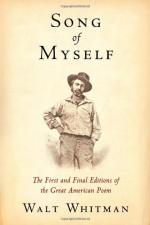|
This section contains 591 words (approx. 2 pages at 400 words per page) |

|
Song of Myself Summary & Study Guide Description
Song of Myself Summary & Study Guide includes comprehensive information and analysis to help you understand the book. This study guide contains the following sections:
This detailed literature summary also contains Bibliography on Song of Myself by Walt Whitman.
Walt Whitman's "Song of Myself" is the most famous of the twelve poems originally published in Leaves of Grass, the collection for which the poet is most widely known. First published in 1855, Whitman made extensive revisions to the book, changing titles, motifs, and adding whole poems until 1881, and tinkering further until his death in 1892. The title "Song of Myself" did not come about until 1881, going through various permutations that include "Poem of Walt Whitman, an American," "Walt Whitman," and "Myself." Its changing title hints at the shifts found within the sprawling epic. From the obvious "Walt Whitman" to the abstract "Myself," Whitman reveals his desire to examine the individual, the communion between individuals, and the individual's place in the universe. The poem is at once a meditation on what it is to be human, a song to the America that Whitman felt so passionately about, and a sermon about the equality of man. Its free-verse construction, devoid of conventional meter and rhyme, mirrors the expansive, sensual, often sexual, language that marked the poem as something totally new. An early criticism of Leaves of Grass in the September 15, 1855, edition of the Brooklyn Daily Eagle explains,
Here we have a book which fairly staggers us. It sets all the ordinary rules of criticism at defiance. It is one of the strangest compounds of transcendentalism, bombast, philosophy, folly, wisdom, wit and dullness which it ever catered into the heart of man to conceive…. It is a poem; but it conforms to none of the rules by which poetry has ever been judged.
Born in West Hills, New York, just thirty years after George Washington was inaugurated, Whitman was raised by working-class, liberal parents during the most nationalistic period in American history. Pride in the newly formed country's success was widespread, yet no indigenous work of literature existed to reflect the native culture, the landscape, or the political idealism of America. In his 1837 "American Scholar" address, Ralph Waldo Emerson challenged his listeners: "Our day of dependence, our long apprenticeship to the learning of other lands, draws to a close…. We have listened too long to the courtly muses of Europe." In the 1955 introduction to Whitman's Leaves of Grass, Gay Wilson Allen tells that the challenge sparked the poet's imagination. In 1849, one of the characters from Henry Wadsworth Longfellow's Kavanagh shouted, "We want a national literature altogether shaggy and unshorn, that shall shake the earth, like a herd of buffaloes thundering over the prairies!" Whitman responded to the call with the earth-shaking Leaves of Grass, the first truly American collection of poetry written by a great American poet.
Before publishing Leaves of Grass, Whitman worked as a newspaper apprentice, a teacher, a journalist, and a writer of short fiction. His working-class background gave him compassion for the disenfranchised. His passion for democracy and equality made him detest slavery. His frustration with the political climate leading up to the Civil War inspired him with poetic fervor. It is interesting, then, that these elements come together in an utterly indefinable work of poetic genius. Poets, critics, lecturers, and educators have failed to come up with a definitive interpretation of "Song of Myself," though not for lack of trying. Countless books and papers have been written in an attempt to unlock the mysteries of Whitman's mystical, lyrical, poetic journey of the soul. In the end, most agree that the independent reader is responsible for making his or her way through this innovative, challenging, and thoroughly American poem. The version explored here is the final, 1892, or "Deathbed" edition.
Read more from the Study Guide
|
This section contains 591 words (approx. 2 pages at 400 words per page) |

|



